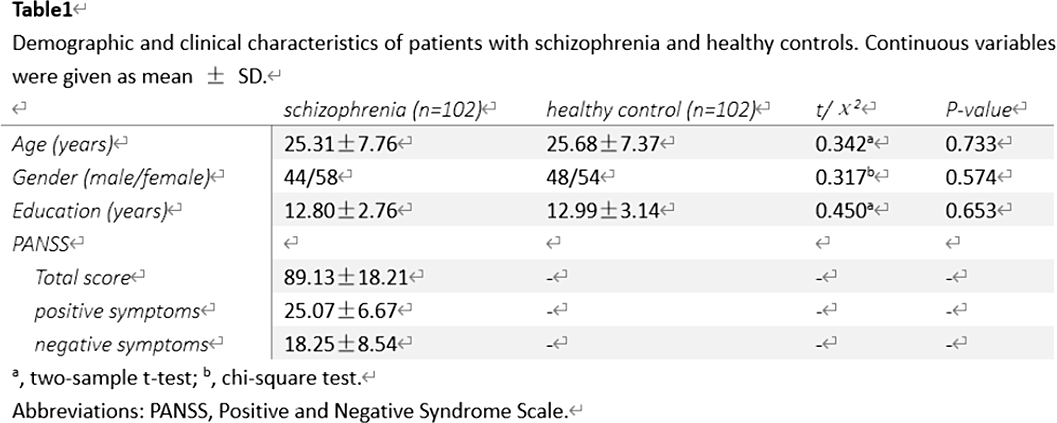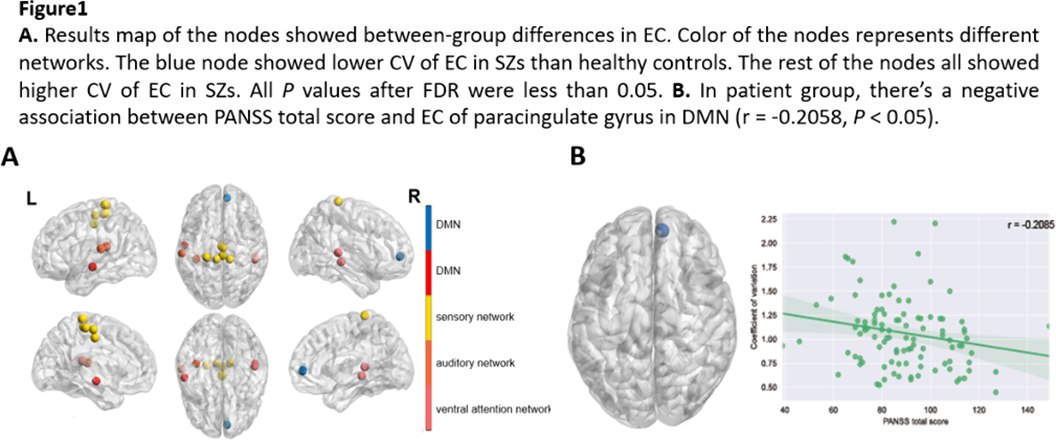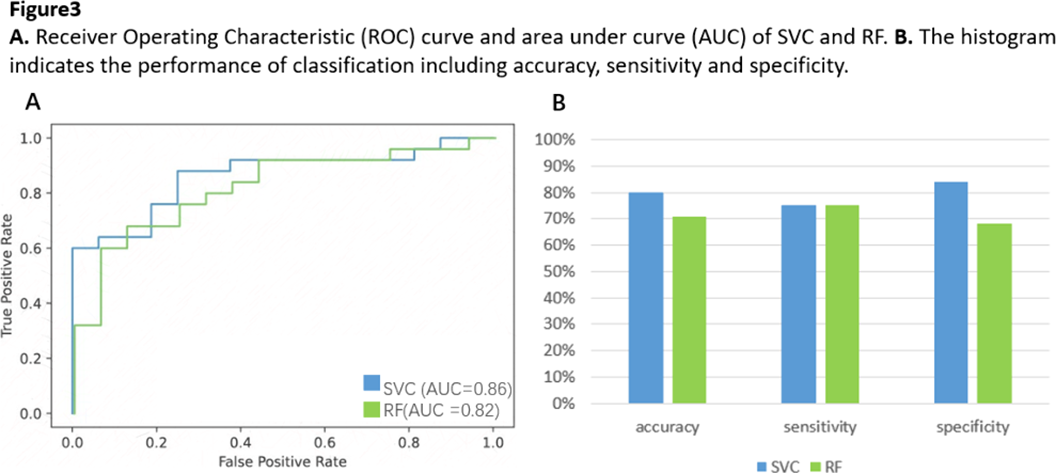495 results
Brain magnetic resonance imaging outperforms clinical severity ratings in the prediction of treatment outcomes in major depressive disorder
-
- Journal:
- European Psychiatry / Volume 67 / Issue S1 / April 2024
- Published online by Cambridge University Press:
- 27 August 2024, p. S85
-
- Article
-
- You have access
- Open access
- Export citation
A multivariate meta-analysis of peripheral cytokine levels in obsessive compulsive disorder
-
- Journal:
- European Psychiatry / Volume 67 / Issue S1 / April 2024
- Published online by Cambridge University Press:
- 27 August 2024, pp. S42-S43
-
- Article
-
- You have access
- Open access
- Export citation
Functional connectivity subtypes of MDD and their associations with gene expression profile, neurotransmitter, and cognition
-
- Journal:
- European Psychiatry / Volume 67 / Issue S1 / April 2024
- Published online by Cambridge University Press:
- 27 August 2024, p. S362
-
- Article
-
- You have access
- Open access
- Export citation
Generation of polarized electron beams through self-injection in the interaction of a laser with a pre-polarized plasma
-
- Journal:
- High Power Laser Science and Engineering / Volume 12 / 2024
- Published online by Cambridge University Press:
- 22 February 2024, e28
-
- Article
-
- You have access
- Open access
- HTML
- Export citation
Fabrication of Anthocyanin/Montmorillonite Hybrid Pigments to Enhance Their Environmental Stability and Application in Allochroic Composite Films
-
- Journal:
- Clays and Clay Minerals / Volume 69 / Issue 1 / February 2021
- Published online by Cambridge University Press:
- 01 January 2024, pp. 142-151
-
- Article
- Export citation
Using simulation as a platform to prepare for ear, nose and throat emergencies in the coronavirus disease 2019 era and beyond
-
- Journal:
- The Journal of Laryngology & Otology / Volume 138 / Issue 4 / April 2024
- Published online by Cambridge University Press:
- 12 September 2023, pp. 466-471
- Print publication:
- April 2024
-
- Article
- Export citation
Competition among the two-plasmon decay of backscattered light, filamentation of the electron-plasma wave and side stimulated Raman scattering
-
- Journal:
- High Power Laser Science and Engineering / Volume 11 / 2023
- Published online by Cambridge University Press:
- 29 August 2023, e76
-
- Article
-
- You have access
- Open access
- HTML
- Export citation
Chapter 6 - Headache
- from Section 2 - Common Neurologic Presentations: A Symptom-Based Approach
-
-
- Book:
- Handbook of Emergency Neurology
- Published online:
- 10 January 2024
- Print publication:
- 17 August 2023, pp 70-83
-
- Chapter
- Export citation
The impact of long memory in mortality differentials on index-based longevity hedges
-
- Journal:
- Journal of Demographic Economics / Volume 89 / Issue 3 / September 2023
- Published online by Cambridge University Press:
- 10 August 2023, pp. 533-552
-
- Article
-
- You have access
- Open access
- HTML
- Export citation
Linked patterns of symptoms and cognition with brain controllability in major depressive disorder
-
- Journal:
- European Psychiatry / Volume 66 / Issue S1 / March 2023
- Published online by Cambridge University Press:
- 19 July 2023, p. S420
-
- Article
-
- You have access
- Open access
- Export citation
A machine learning model for predicting the three-year survival status of patients with hypopharyngeal squamous cell carcinoma using multiple parameters
-
- Journal:
- The Journal of Laryngology & Otology / Volume 137 / Issue 9 / September 2023
- Published online by Cambridge University Press:
- 23 January 2023, pp. 1041-1047
- Print publication:
- September 2023
-
- Article
- Export citation
Design and performance of directional rectification control system in an aircraft with a novel type of wheel-ski landing gear
-
- Journal:
- The Aeronautical Journal / Volume 127 / Issue 1310 / April 2023
- Published online by Cambridge University Press:
- 12 January 2023, pp. 651-675
-
- Article
- Export citation
Effects of environment and breed on growth performance and meat quality of fattening pigs
-
- Journal:
- Animal Welfare / Volume 29 / Issue 2 / May 2020
- Published online by Cambridge University Press:
- 01 January 2023, pp. 177-184
-
- Article
- Export citation
A systematic study on 33 gallbladder stones resembling adult Clonorchis sinensis worms
-
- Journal:
- Journal of Helminthology / Volume 96 / 2022
- Published online by Cambridge University Press:
- 27 December 2022, e90
-
- Article
-
- You have access
- Open access
- HTML
- Export citation
Should mild obstructive sleep apnoea be treated? A systematic review from the standpoint of disease progression
-
- Journal:
- The Journal of Laryngology & Otology / Volume 137 / Issue 8 / August 2023
- Published online by Cambridge University Press:
- 16 November 2022, pp. 828-839
- Print publication:
- August 2023
-
- Article
- Export citation
An update on the management of thyroid nodules: rationalising the guidelines
-
- Journal:
- The Journal of Laryngology & Otology / Volume 137 / Issue 9 / September 2023
- Published online by Cambridge University Press:
- 02 November 2022, pp. 965-970
- Print publication:
- September 2023
-
- Article
- Export citation
Brain controllability and clinical relevance in schizophrenia
-
- Journal:
- European Psychiatry / Volume 65 / Issue S1 / June 2022
- Published online by Cambridge University Press:
- 01 September 2022, p. S196
-
- Article
-
- You have access
- Open access
- Export citation
Altered dynamic functional topology in first-episode untreated patients with schizophrenia can aid in early diagnosis
-
- Journal:
- European Psychiatry / Volume 65 / Issue S1 / June 2022
- Published online by Cambridge University Press:
- 01 September 2022, p. S115
-
- Article
-
- You have access
- Open access
- Export citation
Remote Assessment of Disease and Relapse in Major Depressive Disorder (RADAR-MDD): Recruitment, retention, and data availability in a longitudinal remote measurement study
-
- Journal:
- European Psychiatry / Volume 65 / Issue S1 / June 2022
- Published online by Cambridge University Press:
- 01 September 2022, p. S112
-
- Article
-
- You have access
- Open access
- Export citation
Prediction and copy number variation identification of ZNF146 gene related to growth traits in Chinese cattle
-
- Journal:
- The Journal of Agricultural Science / Volume 160 / Issue 5 / October 2022
- Published online by Cambridge University Press:
- 10 August 2022, pp. 404-412
-
- Article
- Export citation






